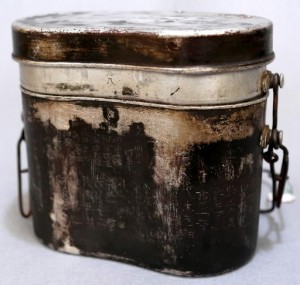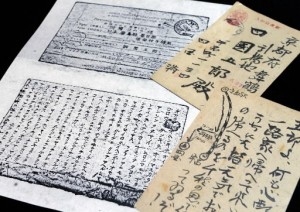Exhibition is held of works of Goro Shiokoku, artist who was POW in Siberia and expressed anger toward war and atomic bombings
Oct. 19, 2015
by Hiromi Morita, Staff Writer
Items which shed light on artist Goro Shikoku’s experience as a prisoner of war in Siberia some 70 years ago have been recently discovered. These items, along with his works and other materials connected to his time in Siberia, will be shown in an exhibition planned by a local volunteer group. The exhibition, which will open on October 12 at the Hiroshima Prefectural Culture Center, will convey what his life was like during this period of detention and how the experience shaped the post-war output of the Hiroshima artist, who expressed his anger toward war and the atomic bombings through his paintings. Mr. Shikoku died in March 2014 at the age of 89.
Mr. Shikoku was called up for military service in 1944 and held as a prisoner of war in Siberia for three years, where he nearly died from malnutrition and frostbite. He returned home in 1948 and learned that one of his brothers was killed in the atomic bombing. While Mr. Shiokoku worked as a municipal government employee, he became a member of a poetry circle that published the first Warera no Uta (Our Poems) magazine in 1949. This group also included the well-known poet Sankichi Toge. They held the first Hiroshima Peace Art Exhibition in 1955 and continued to express their antiwar stance through poetry and art.
Among the newly discovered items are a postcard he wrote in the Soviet Union shortly before returning home, to let his family know that he was alive, and a postcard from his older brother that he received at Maizuru, Kyoto, where he landed. A camping pot that Mr. Shikoku brought back from Siberia was also found by family members among his belongings in the city of Kyoto.
Since Mr. Shikoku did not know that his younger brother was dead, he wrote to him on the postcard, “I hope you are stepping up to help support the family.” On the surface of the camping pot, he engraved the name of his unit, a drawing of a building that appears to be the internment camp, and the names of more than 50 fellow soldiers. In a note, he indicated that he painted the pot to make a “hidden list” of the names.
The exhibition is a sequel to a retrospective held by volunteers this past April. More than 60 works will be displayed, most of which are watercolor paintings and sketches that depict his life amid the brutal conditions of Siberia. A rucksack Mr. Shikoku made and the shoes he wore there will also be displayed. His memoir has been made into a video, in which a narrator reads such episodes as how he managed to survive under the extreme conditions of the camp in Siberia and the shock he felt upon learning of his brother’s death.
Mr. Shikoku’s son, Hikaru, 59, said, “I can see how doggedly my father tried to leave behind a record of his experience for others to see. He described how he endured the intense cold and hunger, his fear of death, and his encounter with a foreign culture. He described his intense experience from all angles in a wide variety of ways.”
The exhibition will open at 1 p.m. on October 12 and close on October 18. Admission is free.
(Originally published on October 9, 2015)
Items which shed light on artist Goro Shikoku’s experience as a prisoner of war in Siberia some 70 years ago have been recently discovered. These items, along with his works and other materials connected to his time in Siberia, will be shown in an exhibition planned by a local volunteer group. The exhibition, which will open on October 12 at the Hiroshima Prefectural Culture Center, will convey what his life was like during this period of detention and how the experience shaped the post-war output of the Hiroshima artist, who expressed his anger toward war and the atomic bombings through his paintings. Mr. Shikoku died in March 2014 at the age of 89.
Mr. Shikoku was called up for military service in 1944 and held as a prisoner of war in Siberia for three years, where he nearly died from malnutrition and frostbite. He returned home in 1948 and learned that one of his brothers was killed in the atomic bombing. While Mr. Shiokoku worked as a municipal government employee, he became a member of a poetry circle that published the first Warera no Uta (Our Poems) magazine in 1949. This group also included the well-known poet Sankichi Toge. They held the first Hiroshima Peace Art Exhibition in 1955 and continued to express their antiwar stance through poetry and art.
Among the newly discovered items are a postcard he wrote in the Soviet Union shortly before returning home, to let his family know that he was alive, and a postcard from his older brother that he received at Maizuru, Kyoto, where he landed. A camping pot that Mr. Shikoku brought back from Siberia was also found by family members among his belongings in the city of Kyoto.
Since Mr. Shikoku did not know that his younger brother was dead, he wrote to him on the postcard, “I hope you are stepping up to help support the family.” On the surface of the camping pot, he engraved the name of his unit, a drawing of a building that appears to be the internment camp, and the names of more than 50 fellow soldiers. In a note, he indicated that he painted the pot to make a “hidden list” of the names.
The exhibition is a sequel to a retrospective held by volunteers this past April. More than 60 works will be displayed, most of which are watercolor paintings and sketches that depict his life amid the brutal conditions of Siberia. A rucksack Mr. Shikoku made and the shoes he wore there will also be displayed. His memoir has been made into a video, in which a narrator reads such episodes as how he managed to survive under the extreme conditions of the camp in Siberia and the shock he felt upon learning of his brother’s death.
Mr. Shikoku’s son, Hikaru, 59, said, “I can see how doggedly my father tried to leave behind a record of his experience for others to see. He described how he endured the intense cold and hunger, his fear of death, and his encounter with a foreign culture. He described his intense experience from all angles in a wide variety of ways.”
The exhibition will open at 1 p.m. on October 12 and close on October 18. Admission is free.
(Originally published on October 9, 2015)









